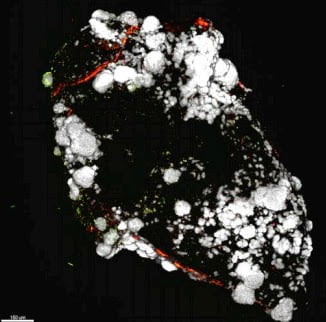Unique visual stimulation may be new treatment for Alzheimer’s
Noninvasive technique reduces beta amyloid plaques in mouse models of Alzheimer’s disease.Watch Video
Anne Trafton | MIT News Office
December 7, 2016
In a study of mice that were genetically programmed to develop Alzheimer’s but did not yet show any plaque accumulation or behavioral symptoms, Tsai and her colleagues found impaired gamma oscillations during patterns of activity that are essential for learning and memory while running a maze.
Next, the researchers stimulated gamma oscillations at 40 hertz in a brain region called the hippocampus, which is critical in memory formation and retrieval. These initial studies relied on a technique known as optogenetics, co-pioneered by Boyden, which allows scientists to control the activity of genetically modified neurons by shining light on them. Using this approach, the researchers stimulated certain brain cells known as interneurons, which then synchronize the gamma activity of excitatory neurons.
After an hour of stimulation at 40 hertz, the researchers found a 40 to 50 percent reduction in the levels of beta amyloid proteins in the hippocampus. Stimulation at other frequencies, ranging from 20 to 80 hertz, did not produce this decline.
Gamma frequency entrainment attenuates amyloid load and modifies microglia
Changes in gamma oscillations (20–50 Hz) have been observed in several neurological disorders. However, the relationship between gamma oscillations and cellular pathologies is unclear. Here we show reduced, behaviourally driven gamma oscillations before the onset of plaque formation or cognitive decline in a mouse model of Alzheimer’s disease. Optogenetically driving fast-spiking parvalbumin-positive (FS-PV)-interneurons at gamma (40 Hz), but not other frequencies, reduces levels of amyloid-β (Aβ)1–40 and Aβ 1–42 isoforms. Gene expression profiling revealed induction of genes associated with morphological transformation of microglia, and histological analysis confirmed increased microglia co-localization with Aβ. Subsequently, we designed a non-invasive 40 Hz light-flickering regime that reduced Aβ1–40 and Aβ1–42 levels in the visual cortex of pre-depositing mice and mitigated plaque load in aged, depositing mice. Our findings uncover a previously unappreciated function of gamma rhythms in recruiting both neuronal and glial responses to attenuate Alzheimer’s-disease-associated pathology.
